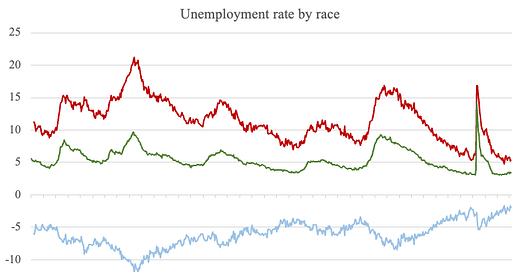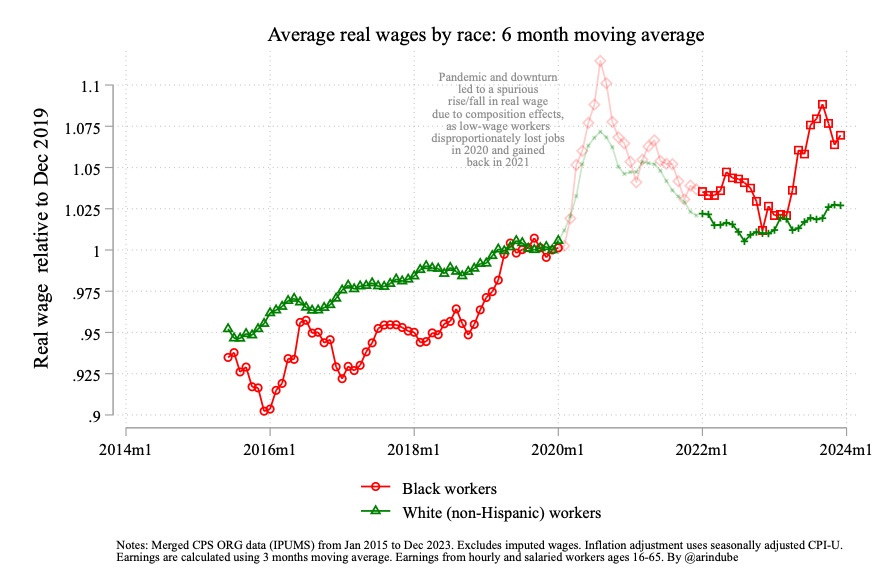The journey towards racial equity in the labor market has been long and complex, with the civil rights movement of the 1960s marking a pivotal moment of promise for greater equity. This era ushered in significant legislative reforms aimed at dismantling the institutional barriers that had long perpetuated racial disparities in the United States. Among these were crucial pieces of civil rights legislation which aimed to reduce discrimination, mitigate disparities in educational access, and improve economic opportunities for Black workers. In addition, expansions in minimum wage coverage in the late 1960s were particularly beneficial to Black workers, who were disproportionately represented in lower-wage jobs. These measures, coupled with changing societal norms, contributed to a notable decrease in the racial earnings differentials during the 1960s and 1970s.
However, the progress experienced in the immediate aftermath of the civil rights movement began to stall by 1980. From this point until 2018, the white/Black wage differential not only ceased to narrow but actually widened, marking a period of stalled progress and growing inequality. Several factors contributed to this reversal, including general increase in wage inequality (which disproportionately harms Black workers), the decline of labor unions, and policy decisions that disproportionately affected Black workers (such as incarceration as well as educational access). The promise of the civil rights era seemed to fade, leaving unresolved the systemic issues that perpetuate racial disparities in the labor market.
Remarkably, the aftermath of the COVID-19 pandemic has presented an unprecedented shift in this long-standing trend. A historically tight labor market has led to a significant reduction in the white/Black wage and unemployment differentials. Today, these differentials are at their lowest levels on record, signaling a moment of surprising progress in the fight against racial divides in the labor market.
Reversing the trends
In 2023, the unemployment rate for Black workers was 5.5 percent, while those of white workers was 3.3 percent. This gap of 2.2 percentage points was lower than anytime since 1972—the earliest such data available.
But it’s not just the unemployment gap that narrowed. Wage growth for Black workers has outpaced those of white workers in recent years for the first time in decades.
Today’s roughly 13 percent white/Black wage differential is the lowest on record. The pace of change is noteworthy. The 6 percentage point (or 6 log point to be more precise) fall in the wage differential over the past 5 years more than reversed the rise in the differential between 2005 and 2018.
While the figure above is for mean wage differential, these findings are similar if we focus on the gap in median wages. Moreover, the sharp decline in the white/Black wage differential occurred for both men and women. The fall in the racial wage gap is a robust, sizable, and important phenomenon.
How large is the 6 percentage point (or around 0.06 log point) reduction in the racial wage gap that happened between 2018 and 2023? To put this in perspective, the weekly log earnings differential between Black and white workers fell by around 0.25 log points between 1965 and 1980. While keeping in mind possible differences between weekly and hourly earnings measures, it is worth noting that the recent reduction in the wage gap over the past five years is almost a quarter as large as the historic gains made during the Civil Rights era. And this 0.06 log point fall in the white/Black wage differential is about as large as the effect Derenoncourt and Montialoux (2020) find from the expansion of minimum wage coverage in the 1960s.
What’s behind these changes?
This recent narrowing of wage and unemployment gaps can be attributed to several key factors. Firstly, the pandemic-induced economic downturn prompted substantial fiscal interventions designed to stabilize and stimulate the economy. These measures included enhanced unemployment benefits, direct financial assistance to individuals and families, and support for small businesses. Such policies not only helped to avert a deeper economic crisis but also facilitated a quicker rebound in employment once the acute phase of the pandemic subsided.
Secondly, the tight labor market that emerged in the pandemic's wake created a scenario where employers, desperate to fill vacancies and resume operations, were compelled to offer higher wages and more inclusive hiring practices. This environment has been particularly beneficial for Black workers, who historically have faced higher levels of unemployment and lower wages compared to their white counterparts. The urgency to fill roles has made employers more willing to bridge the wage gap and employ workers from diverse backgrounds, thereby contributing to a reduction in both wage and employment disparities.
The significance of this development cannot be overstated. It underscores the power of a tight labor market in addressing long-standing inequalities. The current situation presents a valuable lesson for policymakers and economists: proactive macro-economic policies and labor market conditions can play a critical role in reducing racial disparities. It also points to the importance of maintaining momentum in this direction, as the structural issues contributing to racial inequality in the labor market have not been fully eradicated. Finally, even though the federal minimum wage has been unchanged for over 13 years, many states and local areas have enacted strong minimum wage policies since around 2015, which have also helped reduce the racial wage gap.
In conclusion, the recent, surprising fall in the Black/white wage and unemployment differential serves as a reminder of the potential for progress in the pursuit of racial equity in the labor market. It highlights the effectiveness of a tight labor market, supported by strong fiscal policies, in breaking down barriers to equality. While this development is encouraging, it also underscores the need for continued vigilance and targeted efforts to ensure that the gains are sustained and that the underlying causes of racial disparities are systematically addressed. The journey towards racial equity is far from complete, but the current moment offers hope and a blueprint for how to advance this critical cause, while helping raise wages more broadly for American workers.







How similar is the chart for "median real wages by race" versus employing mean?
Very interesting, I wonder how racial equity will look in a slack labor market? Would we see an opposite trend?